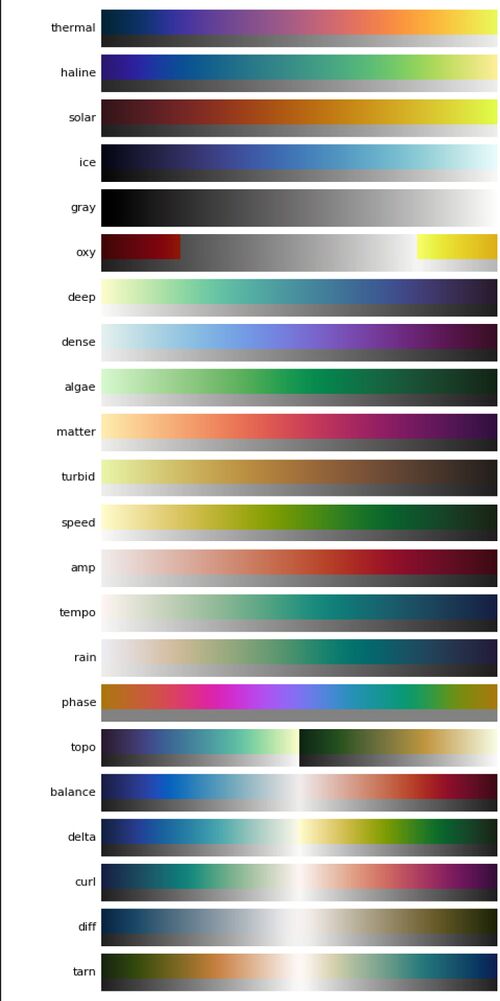Difference between revisions of "Cmocean"
(Created page with "CM Ocean. It’s a programming software that is running MATLAB, in order to output the data which has then been run in the model. It is a visualization that would run alongsid...") |
|||
| (5 intermediate revisions by the same user not shown) | |||
| Line 1: | Line 1: | ||
| − | + | Cmocean is a programme using MATLAB language. It is a visualization modelling software, that attaches color indicators to different scales of data. | |
| + | This turns ocean data into color, like heat stripes, water warming, sea warming, water level rise, salinity. | ||
| − | + | The data that is transformed into these visualizations are quantitative, translated into a scale that is not numerical, and can be considered subjective in terms of colour reception. The aim of CM Ocean is to desubjectify and to make colour scientific. | |
| − | + | [[File:Cmocean index.jpg |500px]] | |
| − | + | CM Ocean is funded by BP, a multinational oil and gas company, and by George Bush. | |
| + | edit: oil company and the Texas Government would like to have a regulated way of understanding the contents of the ocean. | ||
| − | + | The idea of bypassing the the subjectivity of color aims for an avoidance of taste, and rules out physiological reception of colour | |
| − | [[Category: | + | There is an expectation that color can be reproducible, that it can be accurate, that it can correctly represent numerical data, that the representation of colour divorced from numericizing color in the first place, the attributions of CMYK and RGB, i.e.; when colour is printed, it is different to if it’s on a screen. |
| + | |||
| + | The underpinning belief is that regulated color usage can carry the responsibility of honesty. So, to use colors in an honest way is the responsibility of the scientist. But what is honesty in color representation of data points? The previous iteration of cmocean, called JETS, was purportedly not so accurate or precise because it has the movements through the color scale with arbitrary weights. A particular density of colour wasn't related to a particular density of attribute. | ||
| + | |||
| + | edit: Dark purple rather than light yellow might misrepresent the density of the object in question, but you would never know that, because this perceived symbolism is skewed. The gradient of the color has to accelerate and decelerate but it might not do that at the scale of the numerical values have on the back-end. It might be that it looks like it’s getting warmer quickly, but it depending on how this color scale is being applied, it could completely skew the numerical results that you’ve run your model for. | ||
| + | |||
| + | [[Category: Instruments]] | ||
Latest revision as of 02:38, 19 April 2022
Cmocean is a programme using MATLAB language. It is a visualization modelling software, that attaches color indicators to different scales of data. This turns ocean data into color, like heat stripes, water warming, sea warming, water level rise, salinity.
The data that is transformed into these visualizations are quantitative, translated into a scale that is not numerical, and can be considered subjective in terms of colour reception. The aim of CM Ocean is to desubjectify and to make colour scientific.
CM Ocean is funded by BP, a multinational oil and gas company, and by George Bush. edit: oil company and the Texas Government would like to have a regulated way of understanding the contents of the ocean.
The idea of bypassing the the subjectivity of color aims for an avoidance of taste, and rules out physiological reception of colour
There is an expectation that color can be reproducible, that it can be accurate, that it can correctly represent numerical data, that the representation of colour divorced from numericizing color in the first place, the attributions of CMYK and RGB, i.e.; when colour is printed, it is different to if it’s on a screen.
The underpinning belief is that regulated color usage can carry the responsibility of honesty. So, to use colors in an honest way is the responsibility of the scientist. But what is honesty in color representation of data points? The previous iteration of cmocean, called JETS, was purportedly not so accurate or precise because it has the movements through the color scale with arbitrary weights. A particular density of colour wasn't related to a particular density of attribute.
edit: Dark purple rather than light yellow might misrepresent the density of the object in question, but you would never know that, because this perceived symbolism is skewed. The gradient of the color has to accelerate and decelerate but it might not do that at the scale of the numerical values have on the back-end. It might be that it looks like it’s getting warmer quickly, but it depending on how this color scale is being applied, it could completely skew the numerical results that you’ve run your model for.
